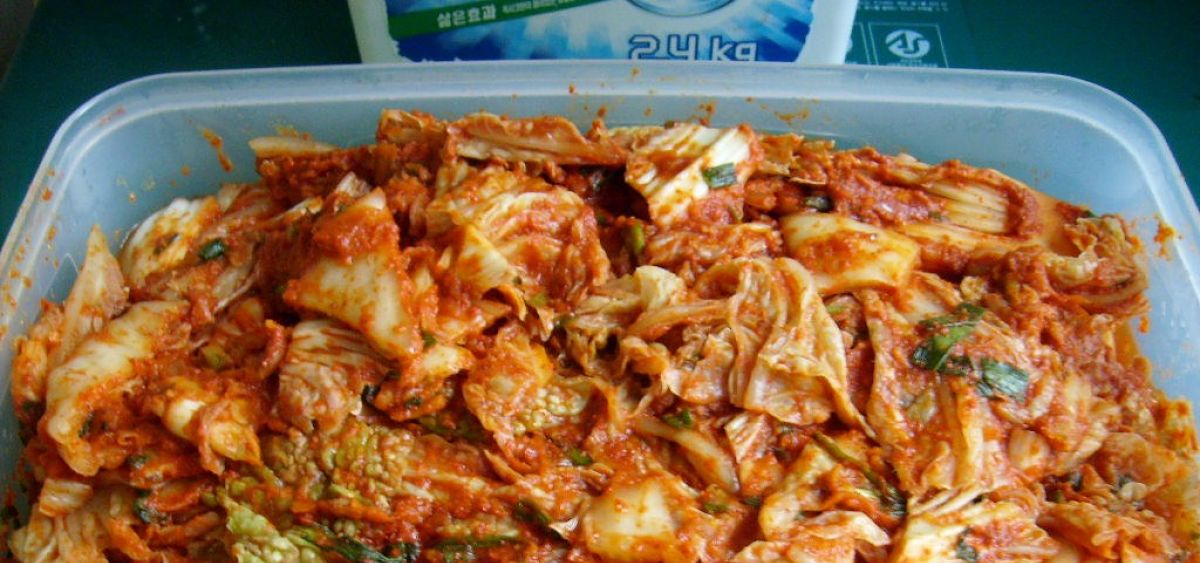Smells Bad! Looks Bad! Tastes Great!

About the first time; you're probably not going to like it! It looks messy and smells nasty! The blend of garlic, anchovy juice and cabbage water combine with a biological and chemical capacity. It lingers on the breath for days! And yet it is one of the world's most exciting taste sensations. If there is one food so able to define a nation, so synonymous with a people, it is kimchi.
Many vegetables can be kimchi-fied, a process which often induces fermentation. The official Kimchi Museum, in Seoul, catalogues almost 200 different types of kimchi the most famous of which is ‘cabbage kimchi,' usually referred to as ‘kimchi'. It is indispensable on a meal table and an integral component in many dishes. For most Koreans, kimchi is their favourite food.
During the Vietnam War, the US government provided a daily kimchi ration to Korean troops. In 2008, it accompanied the first Korean astronaut aboard the International Space Station. Cabbage kimchi is fizzling with microbial activity for which it is highly regarded as a health food. However, the ‘space recipe' had to be microbe-free and research and development was a multi-dollar project! Poor harvests of Chinese cabbage can prompt government intervention. In 2004, a kimchi refrigerator was the most desired household appliance.
Home-made kimchi is always superior to tinned or packaged kimchi. Not only is it cheap and easy to make but doesn't involve cooking. Many websites will guide you through the process and one of the most authentic is Maangchi.com. Ingredients include Chinese leaf cabbage, mooli, ginger, garlic, red pepper powder, and sea salt. Red pepper powder is a coarse type of chilli powder. Fermented fish sauce completes the recipe.
Once sprinkled with salt the cabbages wilt in less than an hour. Make sure you use rock or sea salt; table salt will not wilt leaves! Once made, you can eat kimchi immediately but fermentation continues for much longer. Once fermenting, you can hear and see the microbial activity. A container lid will ‘pop' regularly to release dense and tangy aromas. These you learn to appreciate.
In Korea, evidence of kimchi making accompanies you everywhere. Outside houses chilli plants spill from flower pots. On flat roofs, brown, ceramic kimchi pots form ordered rows. Cabbages, mooli and chilli festoon summer fields. Street markets are a cornucopia of both kimchi ingredients and products. Kimchi's tang even wafts on the air of the arrival lobby at Incheon International airport.
Home-made kimchi is a source of national and family pride. The annual kimchi-making season, known as kimjang, takes place in autumn. It is the culmination of many different traditional processes. Anchovy fished in spring ferment over summer. August is best for drying sea salt. Red chillies drying in the late summer sun fleck rural landscapes.
When families come together for kimjang they will prepare as many as 200 cabbages. These cabbages are not small 'egg cabbages' but hefty ones weighing several kilograms. Kimjang is also the time to make other types of kimchi.
There is always a random element in kimchi production, something beyond the control of the 'cook'. Factors include the temperature, humidity, the season's ingredients, and variations in microbial colonies. Part of the fun involved in kimjang is the pursuit of perfection in the light of random influences.
Every Korean has a liking for a particular type of kimchi and the degree of fermentation and spiciness are important factors. Some like it fresh and crunchy; others prefer the sour bite of old kimchi which draws the tongue like strong red wine. Some prefer it very spicy, some mild. Children often wash away the spicy sauce water.
Present as an accompaniment to most meals, kimchi also forms the basis of many recipes including hearty stews, fried rice, soups, and various pancakes. In fusion- style it is excellent with creamy or cheesy food. Try it with carbonara, macaroni or cauliflower cheese! It is perfect with fried bacon, mashed potatoes and it even works with a Sunday roast. Mixed with a little mayonnaise it transforms into a delicious condiment.
In 2013, UNESCO designated kimchi and kimjang, an ‘intangible cultural heritage of humanity.' The reason is simple. Kimjang and kimchi are a celebration of tradition and identity. Production etches out a seasonal calendar and brings friends, families, fishing, and agriculture communities together. At the same time kimchi provides a regional identity with space for individual flair. Of all the foods capable of representing a nation, kimchi is the most intimate, the most capable. Ask a Korean what components constitute their identity and kimchi will be among them. It is as integral to national identity as is the Korean flag or national anthem.

